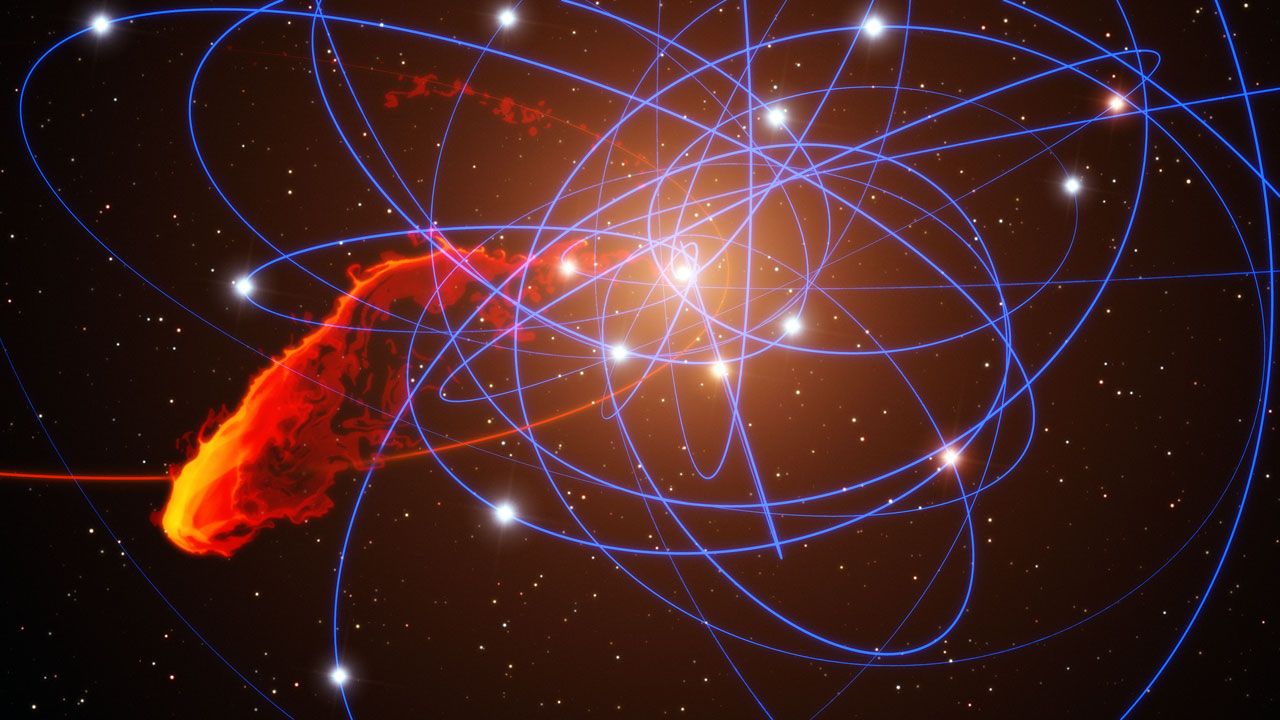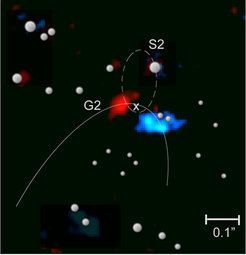Mystery Object Appears Near Milky Way's Monster Black Hole

A mystery object at the center of the galaxy has astronomers scratching their heads, and a new piece of information won't be solving the case before the New Year.
In yet another twist to a saga of astronomical proportions, astronomers now say a gas cloud called G1 made a tight orbit around the supermassive black hole at the center of the Milky Way galaxy 13 years ago. The object could be one in a series of gas clouds, the second of which may soon become a snack for the black hole.
The G1 object can be seen in observational data sets as early as 2004. An object known as G2 has been in the news for more than a year, ever since astronomers at the Max Planck Institute for Extraterrestrial Physics in Germany hypothesized that it was a gas cloud. If that is true, it should lose some of its material to the supermassive black hole at the center of the Milky Way (known as Sagittarius A* or Sgr A*). This giant black hole — its name is pronounced Sagittarius A(star) — doesn't dine on material often, so the event would be a rare chance for astronomers to watch a black hole eat. [Top 10 Strangest Things in Space]
While the scientists at Max Planck contend that G2 is a gas cloud, a group of researchers at the University of California, Los Angeles, led by astrophysicist Andrea Ghez, argue that G2 is more likely a star surrounded by a layer of dust and gas. Over the summer, G2 made its closest approach to the black hole and was not torn apart. Ghez and her group argued that this was a knockout punch for the gas cloud theory — clear evidence that G2 is a solid body.

But the researchers at the Max Planck institute countered with an explanation for how G2 could have remained intact even if it is a gas cloud. Their theory incorporates the idea that G2 was once part of a larger gas cloud that subsequently broke up into smaller gas clouds that all follow the same path, like beads on a string. This "beading" of gas has been observed in the universe before. If additional clouds of gas could be identified following the same path as G2, that would strongly indicate that G2 is a gas cloud and not a star, the scientists say.
In their newest paper, the Max Planck group provides a computer model that retraces the path of G1. According to their research, G1 followed a path nearly identical to G2. The model does make certain assumptions about G1's motion — for example, that it decelerated near closest approach to the black hole.
Get the Space.com Newsletter
Breaking space news, the latest updates on rocket launches, skywatching events and more!
"The good agreement of the model with the data renders the idea that G1 and G2 are part of the same gas streamer highly plausible," Stefan Gillessen, a co-author on the new research, said a statement.
The new study was first published on the online preprint journal arXiv.org and has been accepted to the Astrophysical Journal.
Editor's Note: This article was updated to correct the following error: the G1 object was first seen in 2004, and was not, as this article previously stated, "newly discovered."
Follow Calla Cofield @callacofield. Follow us @Spacedotcom, Facebook and Google+. Original article on Space.com.
Join our Space Forums to keep talking space on the latest missions, night sky and more! And if you have a news tip, correction or comment, let us know at: community@space.com.

Calla Cofield joined Space.com's crew in October 2014. She enjoys writing about black holes, exploding stars, ripples in space-time, science in comic books, and all the mysteries of the cosmos. Prior to joining Space.com Calla worked as a freelance writer, with her work appearing in APS News, Symmetry magazine, Scientific American, Nature News, Physics World, and others. From 2010 to 2014 she was a producer for The Physics Central Podcast. Previously, Calla worked at the American Museum of Natural History in New York City (hands down the best office building ever) and SLAC National Accelerator Laboratory in California. Calla studied physics at the University of Massachusetts, Amherst and is originally from Sandy, Utah. In 2018, Calla left Space.com to join NASA's Jet Propulsion Laboratory media team where she oversees astronomy, physics, exoplanets and the Cold Atom Lab mission. She has been underground at three of the largest particle accelerators in the world and would really like to know what the heck dark matter is. Contact Calla via: E-Mail – Twitter